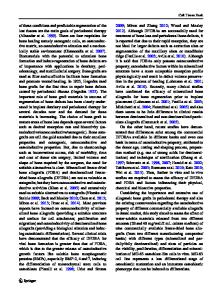Ultrastructure of the Mineralized Tissue/Calcium Phosphate Interface in Vitro
- PDF / 3,120,913 Bytes
- 8 Pages / 420.48 x 639 pts Page_size
- 38 Downloads / 315 Views
ULTRASTRUCTURE OF THE MINERALIZED TISSUE/CALCIUM PHOSPHATE INTERFACE IN VITRO JOOST D. de BRUIJN*, JOHN E. DAVIES", JIM S. FLACH, KLAAS de GROOT, CLEMENS A. van BLITTERSWIJK * Laboratory for Otobiology and Biocompatibility, Biomaterials Research Group, University of Leiden, Rijnsburgerweg 10, 2333 AA Leiden, The Netherlands. # Centre for Biomaterials, University of Toronto, 170 College Street, Toronto, ON, M5S WA1, Canada. ABSTRACT An in vitro rat bone marrow cell (RBMC) system was used to examine the structure of the interface established between calcium phosphates (Ca-P) and mineralized tissue. The Ca-P used, varied either in chemical structure or crystallinity. Therefore, not only the influence of chemical composition, but also the effect of degradation of Ca-P ceramics could be studied. The interfaces were examined with scanning and transmission electron microscopy (SEM and TEM). SEM showed that deposition of mineralized extracellular matrix on the different materials examined varied both in time and morphology. Mineralization started with the formation of afibrillar globules with which collagen fibres became integrated. With TEM, three distinctly different interfacial structural arrangements were observed which were dependent on the presence or absence of an electron dense layer and/or an amorphous zone. The former was considered to be at least partially caused by protein adsorption, which would precede biological mineralization events, whereas the latter was considered to represent partial degradation of the ceramic surfaces. The results of this study showed that interfacial reactions were not only influenced by the chemical structure, but also by the crystallinity of Ca-P ceramics. Thus, characterisation of Ca-P implant materials is of critical importance in achieving a better understanding of the phenomena that occur at the bone-biomaterial interface. INTRODUCTION Calcium phosphate (Ca-P) ceramics are widely used in medicine as bone replacement materials due to their bone-bonding capacities [1-4]. Push-out studies, however, have revealed that chemically different Ca-P display varying bone-bonding properties [5] and it is conceivable that these differences are expressed as structural variations at the bone-biomaterial interface. Indeed, different interfacial structures have been observed between bone tissue and calcium phosphates at the ultrastructural level. Denissen et al. [6] observed a 0-1000 nm thick amorphous zone that was interposed between densely sintered hydroxyapatite (HA) ceramic and the surrounding bone. Jarcho [1] observed a 0.14 tsm thick amorphous layer devoid of collagen fibers forming the interface between dense ceramic apatite and bone, whereas Ganeles et al. [2] described a 0.25 to 0.5 14m thick layer of collagen-free, electron dense, amorphous, granular material at the surface of the same material. Furthermore, van Blitterswijk et al. [3,7] have shown an electron dense layer at the bone-HA interface that was continuous with the lamina limitans of the surrounding middle-ear bone tissue. T
Data Loading...











